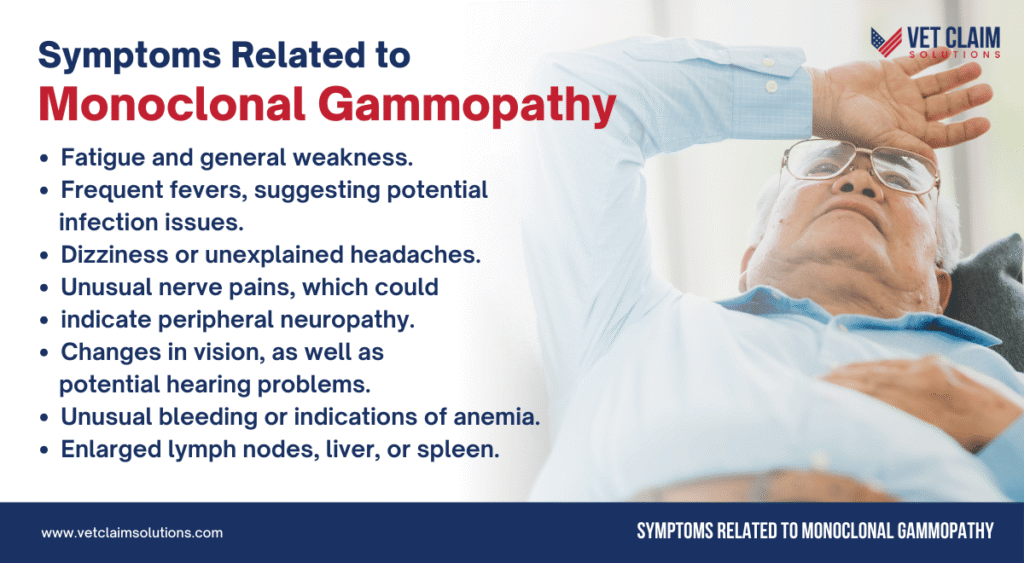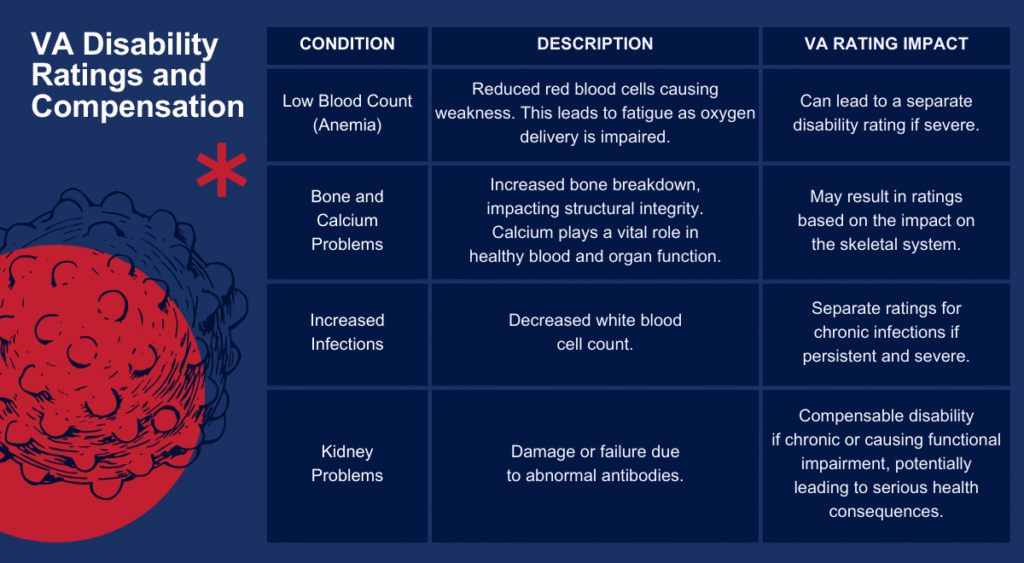If you’re a veteran, the process of seeking benefits can feel overwhelming. You might not know where to start, or you might be lost in a sea of online information and lacking the time to sift through it all. This is especially true if you’re dealing with Monoclonal Gammopathy of Undetermined Significance (MGUS) and exploring VA Disability Benefits for Monoclonal Gammopathy of Undetermined Significance.
MGUS involves abnormal plasma cells. Many veterans exposed to toxins during their military service develop MGUS. It’s important to know that there are resources available to help you understand VA Disability Benefits for Monoclonal Gammopathy of Undetermined Significance.
Understanding Monoclonal Gammopathy of Undetermined Significance (MGUS)

MGUS is a condition where an abnormal protein, known as the monoclonal protein or M-protein, appears in your blood. This protein is produced in your bone marrow.
While MGUS itself often doesn’t cause symptoms, it can sometimes progress to more serious illnesses.
What Causes MGUS and Who is at Risk?
The risk of developing MGUS increases with age. Other factors like infections, immune system problems, and environmental exposures can also play a role.
A 2008 study showed a link between Agent Orange exposure and the later development of multiple myeloma, a more serious condition that MGUS can progress into. Veterans exposed to Agent Orange may be at a higher risk.
How is MGUS Diagnosed?
Doctors use several tests to detect these abnormal proteins in the blood. Blood tests, urine tests, and a procedure called electrophoresis are used to diagnose the condition.
These diagnostic methods help determine if an individual has MGUS.
Symptoms Related to Monoclonal Gammopathy
MGUS often doesn’t present with obvious symptoms, particularly in its mild, stable state.
However, if it progresses, MGUS can manifest in several ways:

MGUS Treatment Options
Not all cases of MGUS require immediate treatment. If the condition is stable and not causing significant symptoms, the typical approach is careful monitoring to see if the patient’s condition changes.
Regular checkups, physical exams, and blood work are common. This allows for early detection of any progression to a more serious condition.
VA Service Connection for MGUS
Establishing service connection typically involves showing that a condition began or was worsened during military service. You need to demonstrate that you have the ailment and also show proof of an event while you served that contributed to the issue.
With MGUS, the process can be slightly more complex due to its non-compensable rating when asymptomatic. Proving this is a crucial step in establishing VA Disability.
Secondary Service Connection
Veterans can connect MGUS to other conditions it causes. This is referred to as secondary service connection.
For this, you need a diagnosis of the secondary condition and evidence showing it’s linked to MGUS. You will have to supply a Nexus and have that somehow tied to your time serving.
The PACT Act and Presumptive Service Connection
The Honoring Our Promise to Address Comprehensive Toxics (PACT) Act of 2022 brought significant changes. It added MGUS to the list of presumptive conditions for veterans exposed to Agent Orange.
This means that if you served in specific locations during certain time periods and have MGUS, the VA presumes a connection. This applies to locations like Vietnam, Thailand, and others listed under the PACT Act.
How the VA Rates MGUS
The VA uses a standardized rating system for disability ratings. The rating methodology is based on 38 CFR § 4.117. They will provide the rating based on this regulation and associated diagnostic codes.
The VA rates MGUS under Diagnostic Code 7712. This code assigns a 0 percent rating for asymptomatic cases.
While a 0 percent rating may seem discouraging, it acknowledges the condition. It can open the door to VA disability benefits.
Understanding VA Disability Ratings for Multiple Myeloma
Multiple myeloma multiple myeloma doesn’t have its own specific diagnostic code within the VA’s Schedule of Rating Disabilities. Instead, it’s rated by analogy to Leukemia or lymphoma, following the broad guidelines of 38 CFR § 4.117.
Ratings under Leukemia also result in a 100% rating, followed by a review approximately six months after the completion of therapy. If you’ve been diagnosed with Multiple Myeloma based on a prior MGUS diagnosis, you have the option to file for a separate review if the outcome doesn’t meet your expectations.
VA Disability Ratings and Compensation
Multiple myeloma is a cancer that affects plasma cells. Myeloma multiple impacts the production of blood-forming cells, affecting various bodily functions.
Conditions associated with Multiple Myeloma can vary widely, including Anemia and complications affecting bones or organs. The VA’s procedures for evaluating disability due to Multiple Myeloma can be intricate because the conditions span multiple body systems:

The VA will assess your condition using VA disability ratings, assigning a 100 percent rating while active cancer treatment is ongoing. Six months after the completion of treatment for Multiple Myeloma, a reevaluation will assess any persistent disabilities. Often, the residual effects of Cancer are what patients must manage as disabilities, even after being “cured”.
Agent Orange and Multiple Myeloma
Multiple Myeloma patients are also eligible for consideration due to toxic exposure from chemicals like Agent Orange, widely used by US Forces during combat, particularly in the Vietnam War.
The VA makes an assumption of exposure if an individual presents with symptoms consistent with in-service exposure. The criteria for veterans exposed can include being stationed nearby, though specifics vary. An assumption that your Multiple Myeloma may be connected to your active military duty in Vietnam between January 9, 1962, and May 7, 1975, is considered a covered condition in certain locations.
Locations such as areas near the Korean DMZ from September 1, 1967, to August 31, 1971, are considered valid for this diagnosis, automatically qualifying you.
Military Burn Pit Exposure Connections
Military burn pits, used for waste incineration, are also linked to Multiple Myeloma in soldiers.
Although not presumed like Agent Orange exposure, demonstrating exposure can lead to consideration. The key element requiring proof of presence is the dioxin TCDD, which was also present in Agent Orange.
Navigating the VA Claims Process
Applying for VA disability benefits involves several steps. Understanding the process makes it significantly more manageable.
Gathering Medical Evidence
Gather all relevant medical records. Highlight any MGUS diagnoses and related complications.
Tests, doctor’s notes, and treatment records are essential. Providing more information is preferable to lacking information during decision-making.

Completing Necessary Forms
You may need specific forms, ensure they are filled out completely and accurately. For cases involving family members affected by related issues, the appropriate form is VA Form 10-10068: Camp Lejeune Family Member Program Application.
The Role of C&P Exams
The VA may request a Compensation and Pension (C&P) examination. This is a physical examination conducted by a VA or VA-approved doctor to assess the current severity of the condition.
It’s essential to attend this evaluation if requested. A missed examination can negatively affect your claim.
This exam also helps confirm whether the in-service ailment can be medically verified.
Building a Strong Claim
Having doctors complete Disability Benefit Questionnaires and providing detailed explanations of your ongoing symptoms can be beneficial.
Statements from yourself and those who served with you can support your claim by establishing a connection to your military service. Make sure they have the full context for what is happening to you.
How Vet Claim Solutions Can Help
Handling VA claims can be challenging and time-consuming. It becomes easier when you’re aware of potential pitfalls. Having expert assistance from VA disability experts can be incredibly valuable.

Conclusion
Veterans with Monoclonal Gammopathy of Undetermined Significance encounter specific obstacles when seeking the help they deserve. Learning about MGUS is a practical first step.
Connecting it to your military service, whether directly or through secondary conditions, is essential for a successful claim. Exploring the available VA programs, including benefits, healthcare, and payments, is also crucial.
If you require support with your disability claim, Vet Claim Solutions is available to provide assistance. We possess the expertise to offer the best possible support and a free case evaluation. Help is available when navigating the disability benefit process. Reach out.


